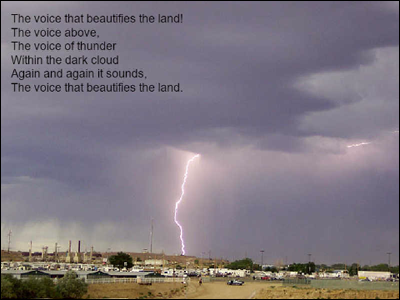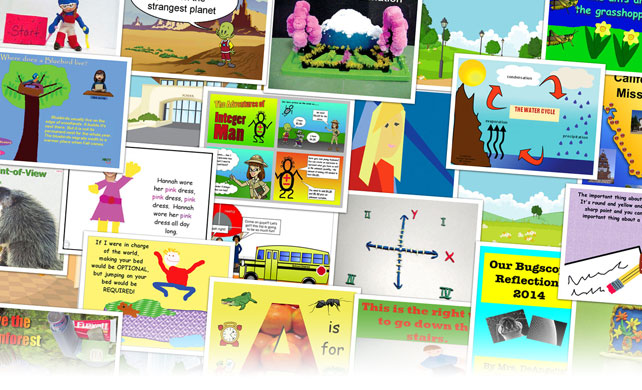

The National Poetry Council is looking for ways to promote interest in poetry. Since most homes have a television, they have decided to broadcast short poems set to music and pictures. They have asked for help to build their collection.
Explore examples of visual poems online. Search SchoolTube or YouTube for your favorite poet or a poem your class has recently read and watch the Getty Institutes how-to video.
Before having students work individually, or in small teams, develop a visual poem as a class.
Read the poem you wish to model to our class or distribute for them to read.
What does the poem mean? Work together to identify specific words that help the reader visualize the meaning or feel a certain way and discuss the intent of the author in using these specific words.
Search an image site like Pics4Learning.com to find images that support the meaning of the text in each line or stanza. Use the words your class identified in the poem to help organize your search. Discuss how well the images that result match the mood and meaning of the poem.
Use a tool like Wixie to combine the images and text. Have a student with strong fluency narrate the visual poem.
Work together to discuss the mood of the poem and find music that is appropriate and add it as a background soundtrack.
Now that you have modeled the process, task students with creating their own. Group students into small teams and assign specific poems or create a collection for students to choose from.
Teams should begin by identifying key words in the poem and discussing the mood or feeling it is meant to evoke.

Using graphic organizers like t-charts and clusters can help students focus on key words and their meanings to determine mood and better comprehend the author's intent.
Try creating graphic organizers with your students in Wixie.
Learn moreHave teams focus on individual lines or verses and locate images that help the viewer better comprehend the meaning and connect to the content. Encourage students to use digital cameras to capture original photos. Apps like Wixie have tools students can use to create illustrations.
Teams should combine the images with text, voice narration, and background music to complete their visual poem.
Share student's visual poems at a poetry festival or poetry event at your school. You can project the visual poems between students reciting poetry orally or showcase during a school-wide event.
To extend the learning and focus on really analyzing each poem, post them individually to your classroom web site, or on morning announcements.
After you have read the poem as a class, you can begin assessing student understanding as they choose key words that evoke feelings or ideas. Evaluate each student’s comprehension as they complete a cluster graphic organizer sheet for their part of the poem. You will want to be available for questions and discussion as they work through their analysis.
You can also evaluate their choice of an image. Remember, the quality of the image reflects both their understanding and analysis of the poem, as well as their ability to complete an effective internet search, visual ability to draw, and/or skill capturing an image with a digital camera.
As they make the movie, listen to the discussions between students. They will be making observations and comments and may even change their mind about their picture. If you are adding music to the background, the musical selection may also indicate student understanding of the poem.
Janeczko, Paul B. (2000) Teaching 10 Fabulous Forms of Poetry. Teaching Resources. ISBN: 0439073464
Sweeney, Jacqueline. (1999) Teaching Poetry: Yes You Can! Scholastic. ISBN: 0590494198
Poetry Anthologies and Thousands of Poems bartleby.com/verse
Project Gutenberg gutenberg.org/catalog
Reading Standards
Craft and Structure
4. Interpret words and phrases as they are used in a text, including determining technical, connotative, and figurative meanings, and analyze how specific word choices shape meaning or tone.
Speaking and Listening Standards
Presentation of Knowledge and Ideas
5. Make strategic use of digital media and visual displays of data to express information and enhance understanding of presentations.
6. Adapt speech to a variety of contexts and communicative tasks, demonstrating command of formal English when indicated or appropriate.
Reading StandardsCC.LA.5.RL.7
Analyze how visual and multimedia elements contribute to the meaning, tone, or beauty of a text (e.g., graphic novel, multimedia presentation of fiction, folktale, myth, poem).
6. Creative Communicator
Students communicate clearly and express themselves creatively for a variety of purposes using the platforms, tools, styles, formats and digital media appropriate to their goals. Students:
a. choose the appropriate platforms and tools for meeting the desired objectives of their creation or communication.
b. create original works or responsibly repurpose or remix digital resources into new creations.
c. contribute constructively to project teams, assuming various roles and responsibilities to work effectively toward a common goal.
d. publish or present content that customizes the message and medium for their intended audiences.
Creative classroom ideas delivered straight to your in box once a month.

What can your students create?

Wixie
Share your ideas, imagination, and understanding through writing, art, voice, and video.

Rubric Maker
Create custom rubrics for your classroom.

Pics4Learning
A curated, copyright-friendly image library that is safe and free for education.

Wriddle
Write, record, and illustrate a sentence.

EDU ToDo
Interactive digital worksheets for grades K-8 to use in Brightspace or Canvas.
Topics